Finite Element Study on Calculation of Nonlinear Soil Consolidation Using Compression and Recompression Indexes
Abstract
1. Introduction
2. Nonlinear Consolidation
2.1. Nonlinear Compressibility
2.2. Nonlinear Permeability
2.3. Degree of Consolidation
2.4. Settlement
3. Finite Element Solution
3.1. Finite Element Equations
3.2. Calculation Flow
4. Case Verification
5. Influence of Consolidation Status
6. Conclusions
- (1)
- The coefficient of consolidation varies nonlinearly during the development of consolidation, due to the change of the effective stress in soil. In particular, the transition from overconsolidation to normal consolidation will exert a significant influence on the coefficient of consolidation;
- (2)
- The two statuses of overconsolidation and normal consolidation should be separately dealt with in consolidation calculations, and using only one kind of consolidation status in calculations fails to accurately reflect real cases;
- (3)
- The nonlinear variations of coefficients in soil exhibit a slighter influence on results under normal consolidation compared with the influence on results under overconsolidation;
- (4)
- The solution presented in this paper is verified through a published engineering case. It is proved that the method is effective, stable, and accurate for meeting engineering requirements.
Author Contributions
Funding
Acknowledgments
Conflicts of Interest
References
- Terzaghi, K.; Peck, R.B.; Mesri, G. Soil Mechanics in Engineering Practice, 3rd ed.; John Wiley & Sons: Hoboken, NJ, USA, 1996. [Google Scholar]
- Huang, J.; Griffiths, D.V. One-Dimensional Consolidation Theories for Layered Soil and Coupled and Uncoupled Solutions by the Finite-Element Method. Géotechnique 2010, 60, 709–713. [Google Scholar] [CrossRef]
- Davis, E.H.; Raymond, G.P. A Non-Linear Theory of Consolidation. Géotechnique 1965, 15, 161–173. [Google Scholar] [CrossRef]
- Abbasi, N.; Rahimi, H.; Javadi, A.A.; Fakher, A. Finite Difference Approach for Consolidation with Variable Compressibility and Permeability. Comput. Geotech. 2007, 34, 41–52. [Google Scholar] [CrossRef]
- Yazdani, H.; Toufigh, M.M. Nonlinear Consolidation of Soft Clays Subjected to Cyclic Loading—Part I: Theory. Geomech. Eng. 2012, 4, 229–241. [Google Scholar] [CrossRef]
- Rujikiatkamjorn, C.; Indraratna, B. Analytical Solution for Radial Consolidation Considering Soil Structure Characteristics. Can. Geotech. J. 2014, 52, 947–960. [Google Scholar] [CrossRef]
- Abuel-Naga, H.M.; Bergado, D.T.; Gniel, J. Design Chart for Prefabricated Vertical Drains Improved Ground. Geotext. Geomembr. 2015, 43, 537–546. [Google Scholar] [CrossRef]
- Buddhima, I.; Rui, Z.; Fox, P.J.; Cholachat, R. Large-Strain Vacuum-Assisted Consolidation with Non-Darcian Radial Flow Incorporating Varying Permeability and Compressibility. J. Geotech. Geoenvironmental Eng. 2017, 143, 04016088. [Google Scholar]
- Hui, W.; Liming, H.; Wengang, Q.; Qingbo, W. Analytical Solution for Electroosmotic Consolidation Considering Nonlinear Variation of Soil Parameters. Int. J. Geomech. 2017, 17, 06016032. [Google Scholar]
- Feng, W.-Q.; Yin, J.-H. Development and Verification of a New Simplified Method for Calculating Settlement of a Thick Soil Layer with Nonlinear Compressibility and Creep. Int. J. Geomech. 2020, 20, 04019184. [Google Scholar] [CrossRef]
- Conte, E.; Troncone, A. One-Dimensional Consolidation under General Time-Dependent Loading. Can. Geotech. J. 2006, 43, 1107–1116. [Google Scholar] [CrossRef]
- Hsu, T.-W.; Liu, H.-J. Consolidation for Radial Drainage under Time-Dependent Loading. J. Geotech. Geoenvironmental Eng. 2013, 139, 2096–2103. [Google Scholar] [CrossRef]
- Lu, M.; Wang, S.; Sloan, S.W.; Indraratna, B.; Xie, K. Nonlinear Radial Consolidation of Vertical Drains under a General Time-Variable Loading. Int. J. Numer. Anal. Methods Geomech. 2015, 39, 51–62. [Google Scholar] [CrossRef]
- Hsu, T.-W.; Tsai, T.-H. Combined Vertical and Radial Consolidation under Time-Dependent Loading. Int. J. Geomech. 2016, 16, 04015073. [Google Scholar] [CrossRef]
- Huang, M.; Li, J. Consolidation of Viscoelastic Soil by Vertical Drains Incorporating Fractional-Derivative Model and Time-Dependent Loading. Int. J. Numer. Anal. Methods Geomech. 2019, 43, 239–256. [Google Scholar] [CrossRef]
- Xie, K.-H.; Xie, X.-Y.; Jiang, W. A Study on One-Dimensional Nonlinear Consolidation of Double-Layered Soil. Comput. Geotech. 2002, 29, 151–168. [Google Scholar] [CrossRef]
- Tang, X.; Niu, B.; Cheng, G.; Shen, H. Closed-Form Solution for Consolidation of Three-Layer Soil with a Vertical Drain System. Geotext. Geomembr. 2013, 36, 81–91. [Google Scholar] [CrossRef]
- Liu, J.-C.; Lei, G.-H.; Zheng, M.-X. General Solutions for Consolidation of Multilayered Soil with a Vertical Drain System. Geotext. Geomembr. 2014, 42, 267–276. [Google Scholar] [CrossRef]
- Moradi, M.; Keshavarz, A.; Fazeli, A. One Dimensional Consolidation of Multi-Layered Unsaturated Soil under Partially Permeable Boundary Conditions and Time-Dependent Loading. Comput. Geotech. 2019, 107, 45–54. [Google Scholar] [CrossRef]
- Zhao, X.-D.; Liu, Y.; Gong, W.-H. Analytical Solution for One-Dimensional Electro-Osmotic Consolidation of Double–Layered System. Comput. Geotech. 2020, 122, 103496. [Google Scholar] [CrossRef]
- Liu, J.-C.; Lei, G.H. One-Dimensional Consolidation of Layered Soils with Exponentially Time-Growing Drainage Boundaries. Comput. Geotech. 2013, 54, 202–209. [Google Scholar] [CrossRef]
- Fu, C.; Lei, G. A General Solution for Vertical-Drain Consolidation with Impeded Drainage Boundaries. J. Cent. South Univ. 2016, 23, 934–943. [Google Scholar] [CrossRef]
- Wang, L.; Sun, D.; Qin, A. Semi-Analytical Solution to One-Dimensional Consolidation for Unsaturated Soils with Exponentially Time-Growing Drainage Boundary Conditions. Int. J. Geomech. 2018, 18, 04017144. [Google Scholar] [CrossRef]
- Feng, J.; Ni, P.; Mei, G. One-Dimensional Self-Weight Consolidation with Continuous Drainage Boundary Conditions: Solution and Application to Clay-Drain Reclamation. Int. J. Numer. Anal. Methods Geomech. 2019, 43, 1634–1652. [Google Scholar] [CrossRef]
- Hansbo, S. Consolidation Equation Valid for both Darcian and Non-Darcian Flow. Géotechnique 2001, 51, 51–54. [Google Scholar] [CrossRef]
- Li, C.; Xie, K. One-Dimensional Nonlinear Consolidation of Soft Clay with the Non-Darcian Flow. J. Zhejiang Univ. Sci. A 2013, 14, 435–446. [Google Scholar] [CrossRef]
- Mishra, A.; Patra, N.R. Long-Term Response of Consolidating Soft Clays around a Pile Considering Non-Darcian Flow. Int. J. Geomech. 2019, 19, 04019040. [Google Scholar] [CrossRef]
- Liu, Z.; Zhang, J.; Duan, S.; Xia, Y.; Cui, P. A Consolidation Modelling Algorithm Based on the Unified Hardening Constitutive Relation and Hansbo’s Flow Rule. Comput. Geotech. 2020, 117, 103233. [Google Scholar] [CrossRef]
- Sandhu, R.S.; Liu, H.; Singh, K.J. Numerical Performance of Some Finite Element Schemes for Analysis of Seepage in Porous Elastic Media. Int. J. Numer. Anal. Methods Geomech. 1977, 1, 177–194. [Google Scholar] [CrossRef]
- Smith, I.M.; Griffiths, D.V.; Margetts, L. Programming the Finite Element Method, 5th ed.; John Wiley & Sons: Hoboken, NJ, USA, 2013. [Google Scholar]
- Mesri, G.; Choi, Y.K. Settlement Analysis of Embankments on Soft Clays. J. Geotech. Eng. 1985, 111, 441–464. [Google Scholar] [CrossRef]
- Buddhima, I.; Sudip, B.; Cholachat, R. Numerical Solution of Stone Column–Improved Soft Soil Considering Arching, Clogging, and Smear Effects. J. Geotech. Geoenvironmental Eng. 2013, 139, 377–394. [Google Scholar]
- Ma, B.-H.; Hu, Z.-Y.; Li, Z.; Cai, K.; Zhao, M.-H.; He, C.-B.; Huang, X.-C. Finite Difference Method for the One-Dimensional Non-Linear Consolidation of Soft Ground under Uniform Load. Front. Earth Sci. 2020, 8, 1–9. [Google Scholar] [CrossRef]
- Chen, R.P.; Zhou, W.H.; Wang, H.Z.; Chen, Y.M. One-Dimensional Nonlinear Consolidation of Multi-Layered Soil by Differential Quadrature Method. Comput. Geotech. 2005, 32, 358–369. [Google Scholar] [CrossRef]
- Rohan, W.; Buddhima, I.; Nagaratnam, S. Vertical and Radial Consolidation Analysis of Multilayered Soil Using the Spectral Method. J. Geotech. Geoenvironmental Eng. 2009, 135, 657–663. [Google Scholar]
- Yang, C.; Carter, J.P. 1-D Finite Strain Consolidation Analysis Based on Isotach Plasticity: Class A and Class C Predictions of the Ballina Embankment. Comput. Geotech. 2018, 93, 42–60. [Google Scholar] [CrossRef]
- Lim, G.T.; Pineda, J.A.; Boukpeti, N.; Carraro, J.A.H. Predicted and Measured Behaviour of an Embankment on PVD-Improved Ballina Clay. Comput. Geotech. 2018, 93, 204–221. [Google Scholar] [CrossRef]
- Das, B.M. Advanced Soil Mechanics, 4th ed.; CRC Press: London, UK, 2013. [Google Scholar]
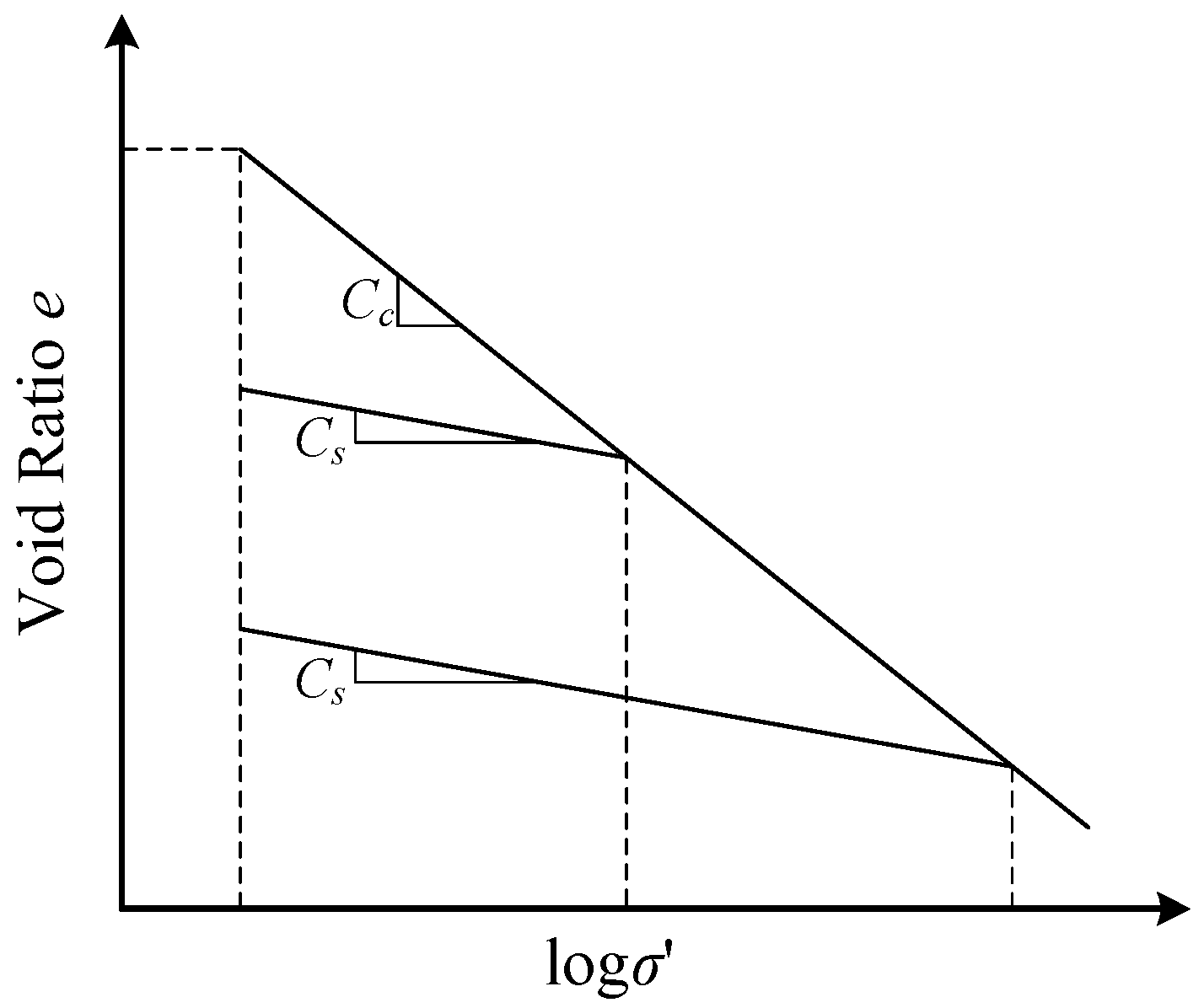

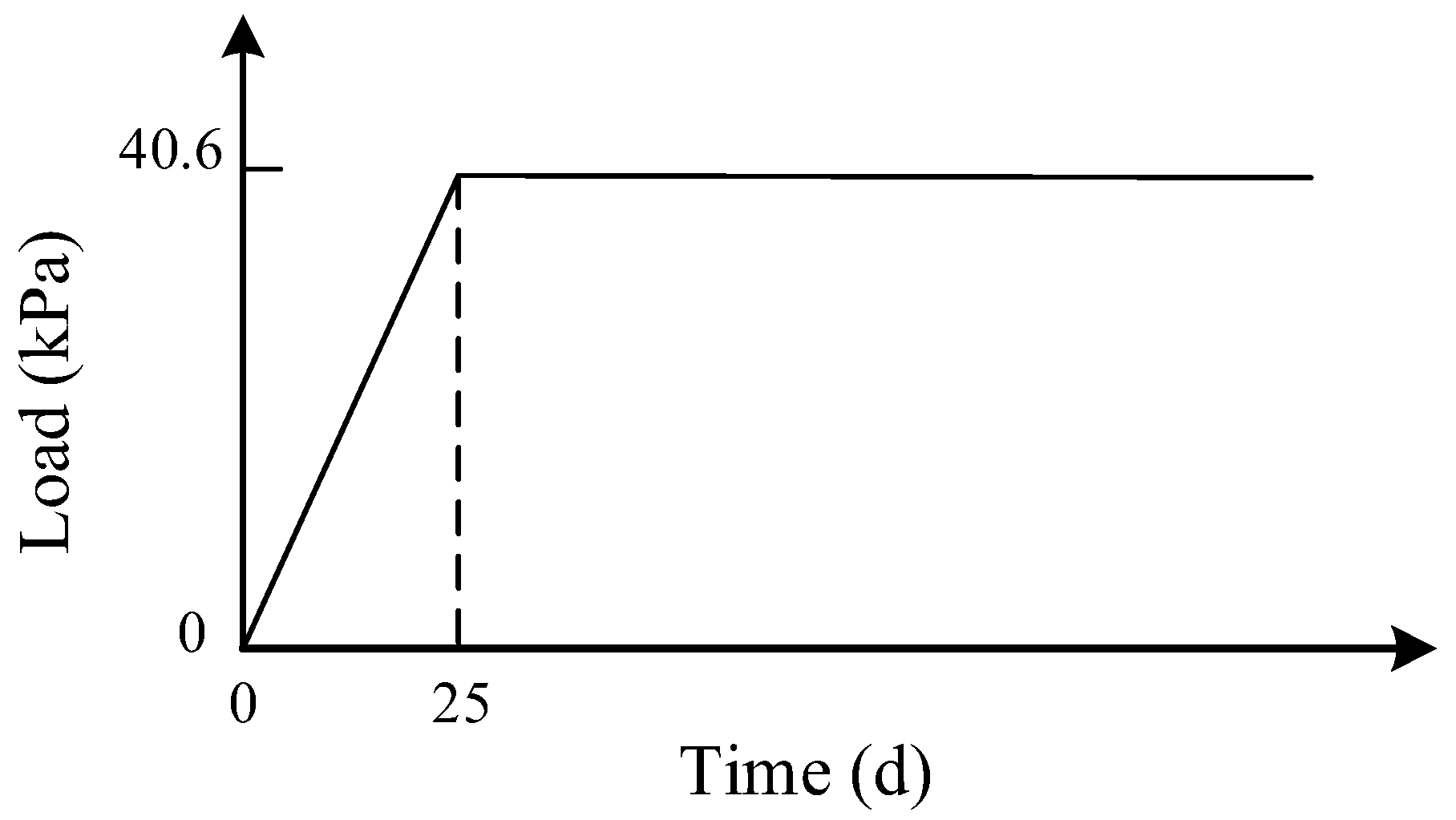

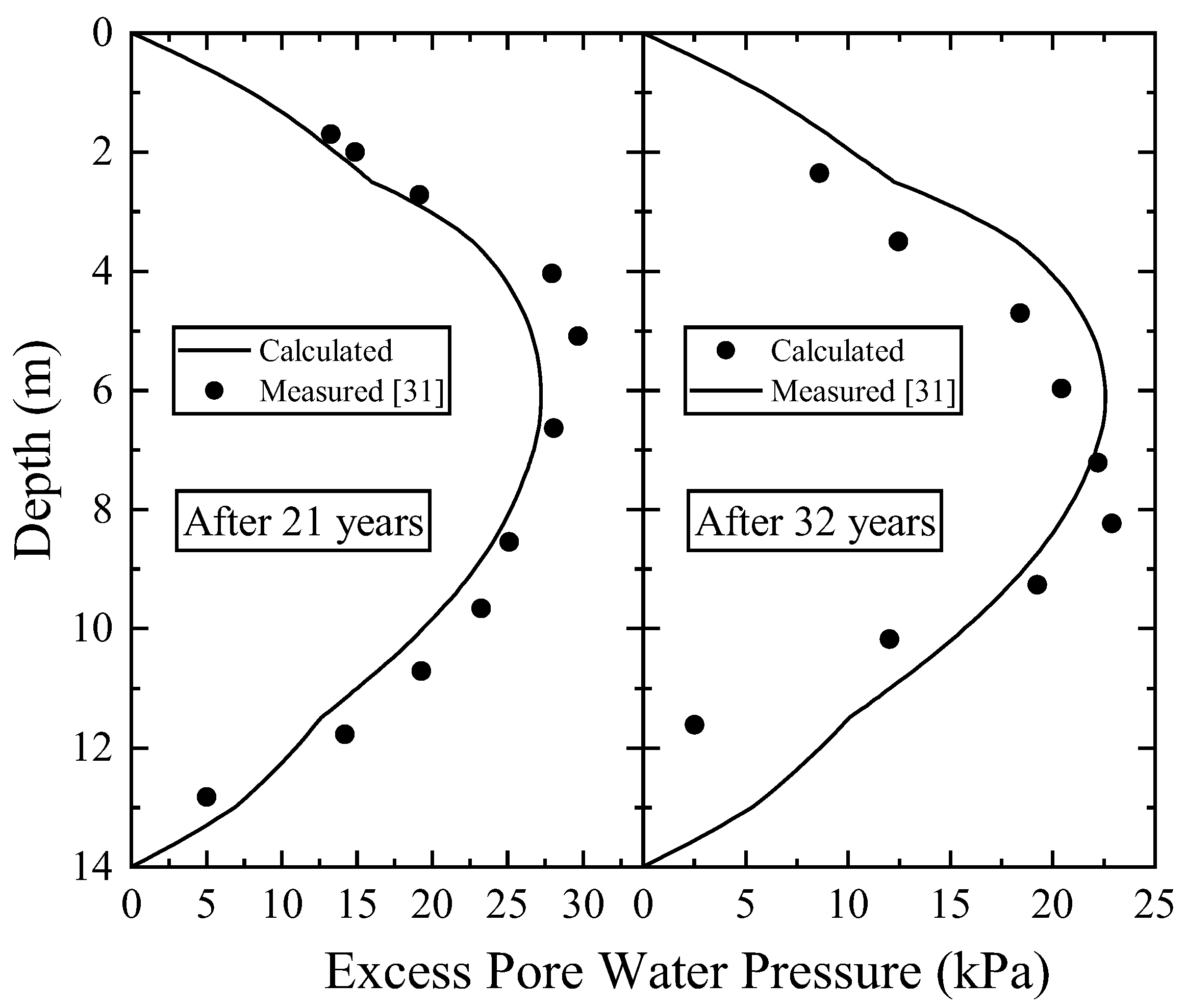



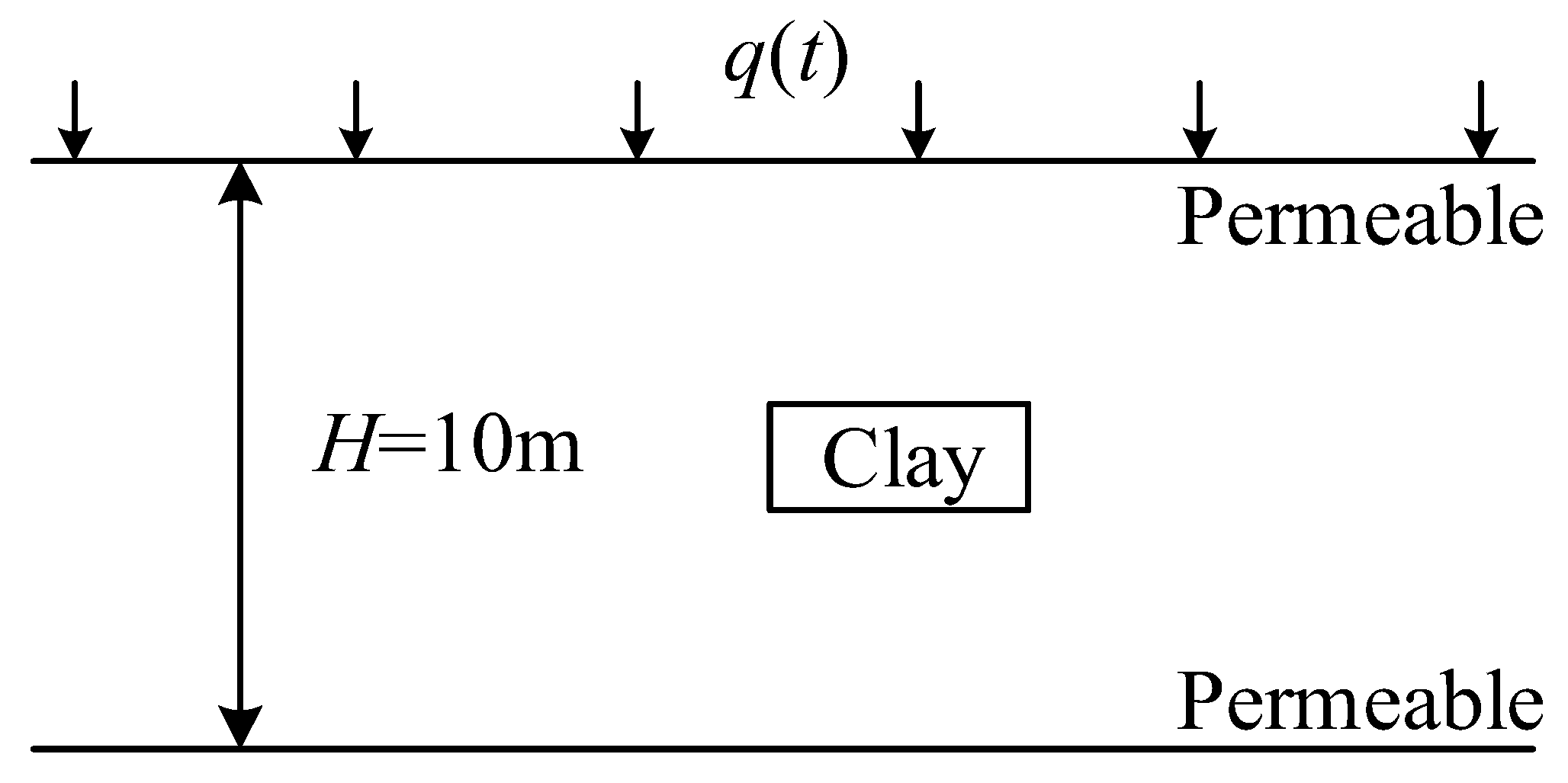
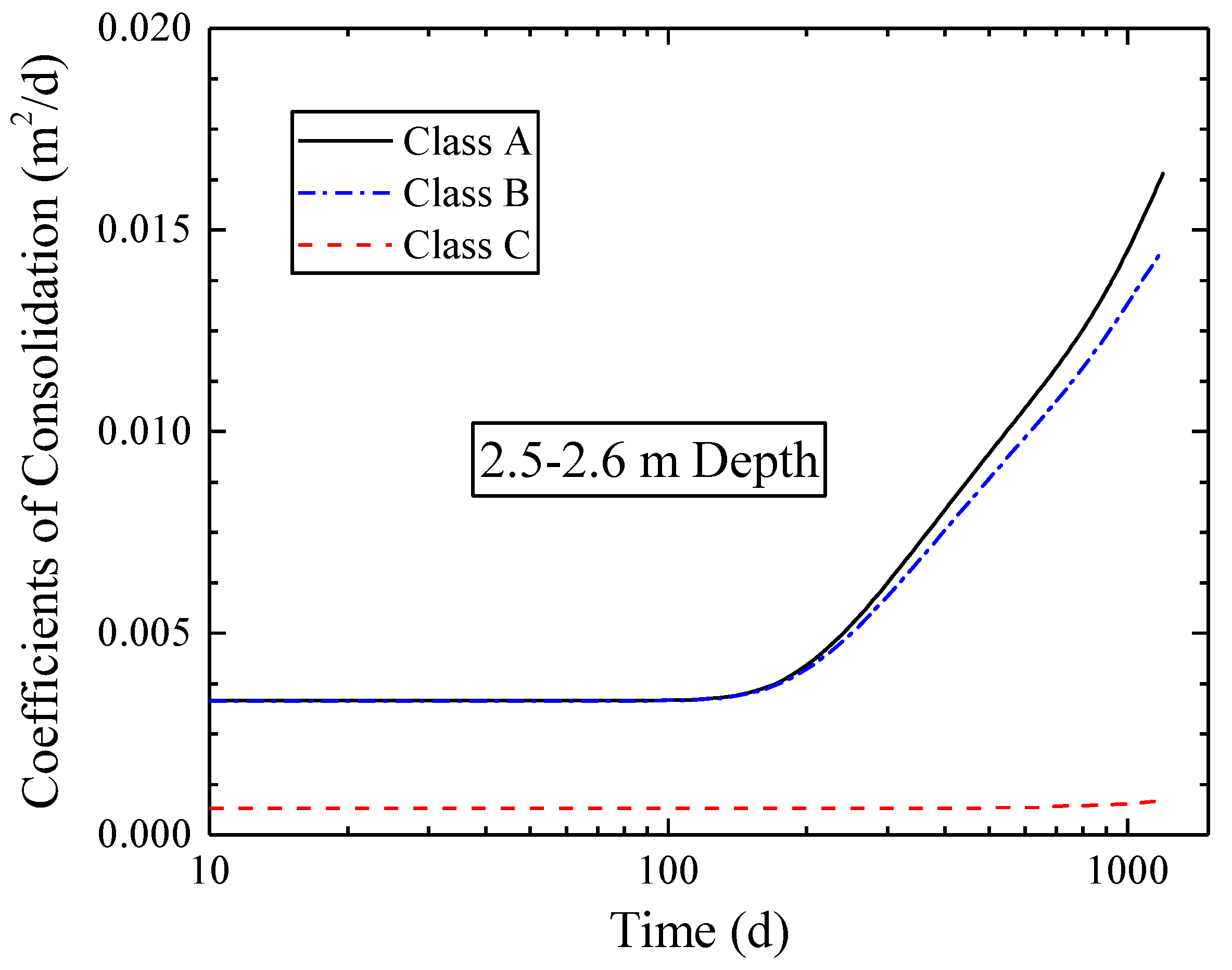
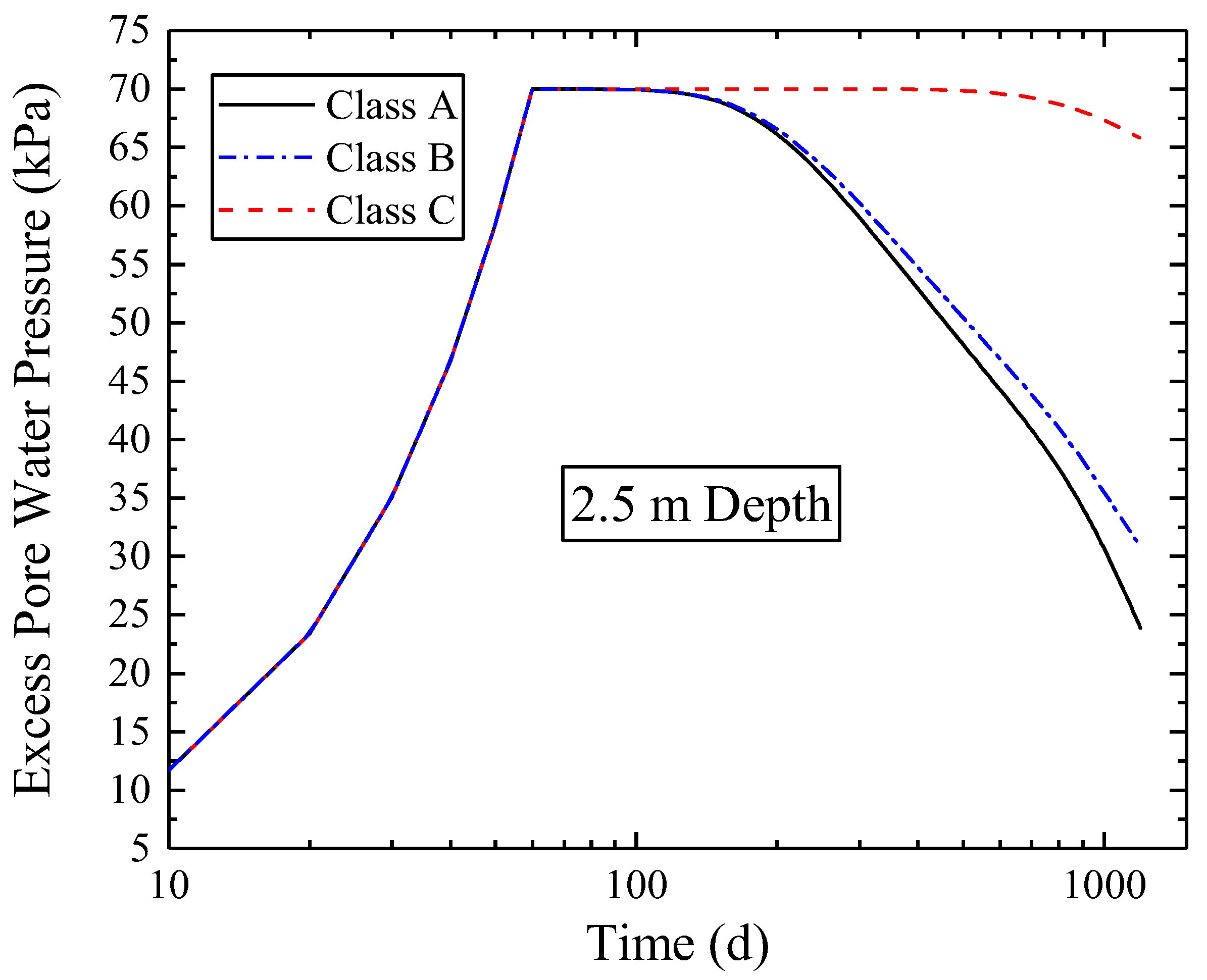

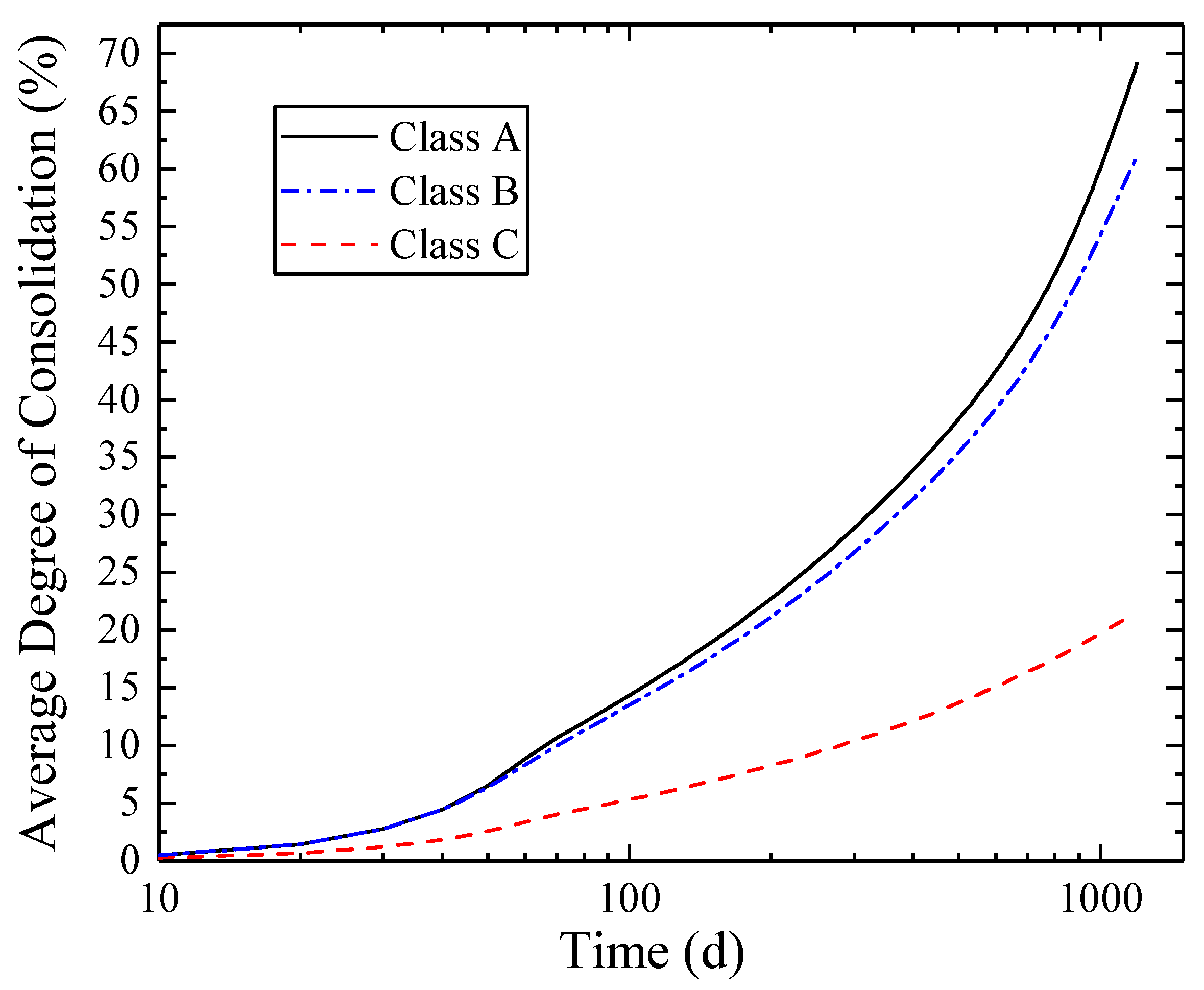
| Layer | h (m) | k0 (m/d) | Ck | e0 | σ0′ (kPa) | σp’ (kPa) | Cs | Cc |
|---|---|---|---|---|---|---|---|---|
| 1 | 1 | 8.67 × 10−5 | 1.16 | 2.51 | 7.03 | 31.72 | 0.15 | 1.43 |
| 2 | 1 | 1.73 × 10−4 | 1.34 | 2.91 | 12.11 | 21.98 | 0.19 | 1.89 |
| 3 | 0.5 | 1.73 × 10−4 | 1.44 | 3.21 | 16.52 | 24.22 | 0.22 | 2.39 |
| 4 | 1 | 9.57 × 10−5 | 1.34 | 2.99 | 20.14 | 25.43 | 0.14 | 2.40 |
| 5 | 1.5 | 1.12 × 10−4 | 1.18 | 2.61 | 26.11 | 32.44 | 0.24 | 2.48 |
| 6 | 2 | 1.12 × 10−4 | 1.18 | 2.61 | 33.39 | 38.14 | 0.27 | 2.63 |
| 7 | 0.5 | 9.59 × 10−5 | 1.08 | 2.41 | 39.15 | 44.71 | 0.17 | 2.10 |
| 8 | 1.5 | 9.64 × 10−5 | 0.93 | 2.08 | 46.20 | 54.67 | 0.11 | 2.14 |
| 9 | 2 | 9.59 × 10−5 | 0.95 | 2.14 | 55.20 | 59.86 | 0.20 | 1.83 |
| 10 | 0.5 | 8.61 × 10−5 | 1.10 | 2.41 | 59.06 | 72.67 | 0.19 | 2.70 |
| 11 | 1.5 | 1.29 × 10−4 | 0.70 | 1.56 | 66.44 | 86.94 | 0.12 | 2.81 |
| 12 | 1 | 1.30 × 10−4 | 0.61 | 1.21 | 74.45 | 89.84 | 0.10 | 2.75 |
| k0 (m/d) | Ck | e0 | Cs | Cc | σ0′ (kPa) | H (m) | γw (kN/m3) |
|---|---|---|---|---|---|---|---|
| 0.00008 | 1.5 | 0.8 | 0.1 | 0.5 | 10 | 10 | 10 |
| Time (Day) | Class A | Class B | Class C | |||
|---|---|---|---|---|---|---|
| Settlement (%) | EPWP (%) | Settlement (%) | EPWP (%) | Settlement (%) | EPWP (%) | |
| 200 | 24.30 | 4.61 | 26.67 | 4.02 | 7 | 0 |
| 400 | 28.68 | 16.17 | 29.91 | 14.22 | 7.06 | 0.02 |
| 600 | 29.62 | 21.94 | 30.67 | 19.31 | 7.25 | 0.24 |
| 800 | 30.02 | 27.10 | 30.99 | 23.36 | 7.58 | 0.71 |
| 1000 | 30.25 | 35.01 | 31.27 | 28.45 | 7.98 | 1.34 |
| 1200 | 30.10 | 45.59 | 31.32 | 33.44 | 8.37 | 2.02 |
© 2020 by the authors. Licensee MDPI, Basel, Switzerland. This article is an open access article distributed under the terms and conditions of the Creative Commons Attribution (CC BY) license (http://creativecommons.org/licenses/by/4.0/).
Share and Cite
Xu, C.; Pan, S. Finite Element Study on Calculation of Nonlinear Soil Consolidation Using Compression and Recompression Indexes. Appl. Sci. 2020, 10, 4737. https://doi.org/10.3390/app10144737
Xu C, Pan S. Finite Element Study on Calculation of Nonlinear Soil Consolidation Using Compression and Recompression Indexes. Applied Sciences. 2020; 10(14):4737. https://doi.org/10.3390/app10144737
Chicago/Turabian StyleXu, Chao, and Suli Pan. 2020. "Finite Element Study on Calculation of Nonlinear Soil Consolidation Using Compression and Recompression Indexes" Applied Sciences 10, no. 14: 4737. https://doi.org/10.3390/app10144737
APA StyleXu, C., & Pan, S. (2020). Finite Element Study on Calculation of Nonlinear Soil Consolidation Using Compression and Recompression Indexes. Applied Sciences, 10(14), 4737. https://doi.org/10.3390/app10144737




